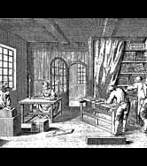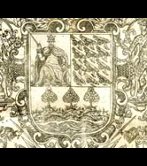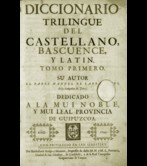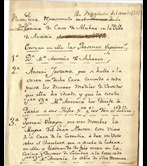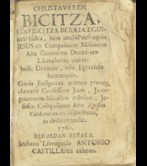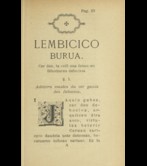Cultural development in Basque
Printing in Gipuzkoa
The invention of the movable printing press by Gutenberg in the mid-15th century represented an undeniable cultural step forward, as knowing how to write was no longer the preserve of the few, and gradually this knowledge began to spread. Likewise, it helped enormously in promoting national languages, to the detriment of Latin, the learned language of the mediaeval age. The Basque language also benefited from the printing press, albeit in a limited, belated manner.
While the records tell us that Pamplona had its own printing press in 1490, in Gipuzkoa they would have to wait until well into the second half of the 16th century before they could take their own first hesitant steps in printing, and that was precisely thanks to a printing press brought from the capital of Navarra. In the second half of the 17th century, it was political developments in the province – thanks to a printed edition of the minutes of the Junta’s meetings – that led to printing being carried out on a continuous basis, thanks to the Ugarte family of printers. The first of these was Martín de Ugarte, who was appointed official printer to the province in 1667. Most of the non-official printed texts were of a religious nature. Following Ugarte’s death in 1678, Tolosa town council appointed his wife Francisca de Akulodi as his successor, followed by his sons Bernardo and Pedro. Bernardo's influence spread to Pamplona, where he printed the second volume of the Annals of Navarra in 1695. The following year he printed the "New Compilation of the Rights, Privileges, best uses and customs, Laws and Orders of the very Noble and very Illustrious Province of Guipuzcoa, printed in Tolosa by Bernardo de Ugarte, Printer for the Province. 1696". The dynasty of printers continued for at least another generation, until the second half of the 18th century.
Bartolomé de Riesgo y Montero, who had lived in San Sebastián since 1735 after having worked for over 10 years for the first printer in Alavés, came to fame thanks to the two volumes of Manuel de Larramendi's "Trilingual Dictionary" that he printed in 1745. His appointment as printer to the province lasted until 1751.
Basque literary production
Literature written in Basque took a while to become consolidated. The book that is considered to be the first to be printed in Basque, "Linguae Vasconum Primitiae", was printed in Bordeaux in 1545. It is a series of poems by Bernat Etxepare from lower Navarra. Apart from this, the subject matter was almost always religious, such as "Christian Doctrine and spiritual pasture of the soul for those in charge of souls and for all states in Castilian and Basque", by Sancho de Elso, published in Estella in 1561; and the "New Testament" of the Protestant minister Joanes Leizarraga, printed in La Rochelle in 1571, etc. It was more than a century before Gipuzkoa would see its first printed work, also religious: "Christian Doctrine in Basque", by Nicolás de Zubia, printed by Pedro de Ugarte in 1691. In contrast, in the 18th century, Gipuzkoa was the province in which the most books were published in Basque.
In the 18th century, the creation of the Real Sociedad Bascongada de Amigos del País had a great impact on the evolution of books in Basque. The volumes produced by the RSBAP and its circle were mostly written in Castilian. Works written by members of the RSBAP figure among the most outstanding contributions to Spanish enlightened reformism in the 18th century; these include "Political recreations", by Nicolás de Arriquibar, "News concerning certain curious productions of Nature", by Ramón María de Munibe (son of the Count of Peñaflorida, the founder of the RSBAP), Samaniego's well-known fables, as well as Santiváñez's moralistic novel, Landazuri's historiography and Prestamero's encyclopaedia.
This environment also generated plays written in Basque, of which a few examples have survived, such as the comic opera in Basque and Castilian by Peñaflorida himself, "El borracho burlado" (1764), and his operetta "Gavon sariac". Meanwhile, a 20-page manuscript was discovered recently that contains a short play written by Joaquín de Alcibar, Captain of the Royal Army and Knight of the Order of Carlos III. It is titled "Gran Tourra", in reference to the trips that noblemen of the time used to make to cities in Italy, Austria, Germany, France and England. It includes the brief "Sukaldeko Disparatiak" (Kitchen nonsense), made up of dialogue between three women talking about the Caballeritos de Azkoitia (the founder members of the RSBAP), and which was first performed in 1771. The author also wrote erudite texts, mythology, caricatures and bertsos.
Beyond this erudite environment, in the 18th century a new kind of book was published in Basque, thanks to the Jesuits. Without any doubt, the most notable exponent was Manuel Garagorri Larramendi (Andoain, 1690 – Azpeitia, 1766), the priest, writer and well-known defender of the Basque language. Although he wrote no more than 200 pages in this language, his influence was huge, both in terms of style and his defence of the language. In 1729 he wrote "The impossible vanquished: the Art of the Basque language", the first Basque grammar book, which was his response to those who looked down on the language. He also wrote the "Trilingual Castilian, Basque, Latin Dictionary" (1745) and other works. His "Corografia", a historical-geographic description of Gipuzkoa, is still considered a major work today.
Two Jesuits, Agustín Cardaveraz from Hernani and Sebastián Mendiburu from Oiartzun, are considered to be Larramendi’s heirs owing to the vibrant, brilliant way they use the language. Born in the early 18th century, they died in exile in Italy, after having been expelled from the order. Their great skill at oratory was expressed best in sermons, for which they became famous in Gipuzkoa and Bizkaia. Virtually all their written work is also religious. Outstanding works by Cardaveraz include: "Cristauaren Vicitza" (The Christian's life), "Aita San Ignacio Loyolacoaren Egercicioac" (Exercises from Father St Ignacio de Loyola), "Ondo iltcen icasteco ta ondo iltcen laguntceco egercicioac" (Exercises to learn how to die well, and to help to die well). The work that is best-known nowadays is "Eusqueraren berri onac" (Basque congratulations, or Basque Rhetoric), printed in Iruña in 1761, and in which the author followed in Larramendi's footsteps by encouraging the correct use of the language. Mendiburu's most outstanding work was "Jesusen Bihotzaren Devocioa" (Devotion to the Heart of Jesus).
